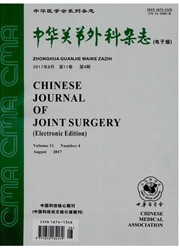

 中文摘要:
中文摘要:
目的探讨人工膝关节表面置换术(TKA)后夹管6h后开放的引流方案相比自体血回输方案对术后并发症的影响。方法接受初始膝关节表面置换手术的骨性关节炎患者91例(103膝),随机分为夹闭组(53膝)和回输组(50膝)。夹管组TKA术后夹闭引流管6h后开放,回输组术后6h内引流液过滤后回输。统计术后总引流量和自体血回输量、异体血输血量,同步监测术前和术后第1、3、6天血常规,通过Gross方程计算隐性出血量和总失血量。记录手术前后的患肢周径了解肢体肿胀幅度,记录切口愈合等级判断感染并发症,检查术后下肢血管超声排查下肢静脉血栓(DVT),记录术后关节活动度了解关节粘连情况。结果夹管组总引流量(161.13±138.63)ml,与回输组(798.20±337.93)ml比较有统计学差异(t=12.65,P〈0.01)。夹管组隐性失血量(712.77±338.22)ml,与回输组(793.54±325.50)ml比较无统计学差异(t=1.23,P〉0.05);但夹管组总失血量(1024.85±422.68)ml,与回输组(1561.54±416.83)ml比较有统计学差异(t=6.48,P〈0.01)。夹管组异体血输注率56.00%,平均输血量(150.94±159.74)ml,与回输组比较无统计学差异[异体血输血率65.31%(x~2=0.90,P〉0.05),输血量(200.00±169.71)ml(t=1.50,P〉0.05)]。术后第1、3、6天夹管组大腿及小腿周径增幅与回输组无统计学差异(P〉0.05)。术后14d膝关节夹管组活动度(96.53°±6.07°),与回输组(96.72°±6.85°)比较无统计学差异(t=0.15,P〉0.05)。夹管组出现2例切口乙级愈合,1例股深静脉血栓(DVT),回输组切口全部甲级愈合,无DVT发生,但是,切口感染率和DVT发生率无组间统计学差异(t=0.17,P〉0.05)。结论 TKA术后引流管暂时夹闭6h后开放的引流方案较自体血回输方案可显著减少术后失血和引流量,不增加异体血输血率和输血量,同时,不影响肢体肿胀程度和术后近期关节
 英文摘要:
英文摘要:
Objective To compare the post-total knee arthroplasty (TKA) complications while using different drainage strategies (the 6-hour clamping and salvage blood transfusion). Methods 103 cases (91 patients) of primary TKA were randomly allocated into a drainage-clamping group (DC group, 53 cases) and autotransfusion group (AF group, 50 cases). Within the first 6 hours after surgery, the drainage tube was clamped in the DC group, while the drainage was salvaged for blood autotrasnfusion in the AF group. Volume of drainage, autotransfusion and allogeneic transfusion were recorded; the hemoglobin and hematocrit were monitored on 1st day, 3rd day and 6th day post-operatively to calculate the amount of both hidden and total blood loss by the Gross equation. Level of the limb swelling was evaluated by comparing the pre- and post-operative circumference of the operated leg. Infection ratio was judged by grading the wound healing. Ultrasonograph and postoperative range of motion (ROM) were also examined to revealing deep vein thrombosis (DVT) or intra-capsular inhesion. Results The total drainage of the DC group was (161.13±138.63) ml, which was significantly less than that of the AF group (798.20±337.93) ml (t=12.65, P〈0.01). The volume of hidden blood loss in DC group was (793.54±325.50) ml) and (712.77±338.22) ml in AF group, which was not significantly different between the two groups (t=1.23, P〉0.05). The volume of total blood loss was (1024.85±422.68) ml in the DC group, which was significantly less than that of the AF group (1561.54±416.83) ml (t=6.48, P〈0.01). The post-operative hemoglobin decrement of DC group was also lower than that of the AF group (P〈0.01). 56% patients of the DC group received (150.94±159.74) ml allogeneic blood transfusion, which was not significantly different with that of the AF group; the allotransfusion ratio was 65.31% (P〉0.05), and the transfusion volume was (200.00±169.71) ml (P〉0.05).
 同期刊论文项目
同期刊论文项目
 同项目期刊论文
同项目期刊论文
 期刊信息
期刊信息
